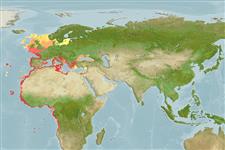Common names from other countries
>
Eupercaria/misc (Various families in series Eupercaria) >
Sparidae (Porgies)
Etymology: Boops: Greek, bous = caw + Greek, ops = appearance, 1854 (Ref. 45335).
More on author: Linnaeus.
Environment: milieu / climate zone / depth range / distribution range
Sinh thái học
Biển gần đáy; Ở đại duơng, biển (Ref. 51243); Mức độ sâu 0 - 350 m (Ref. 26999), usually 0 - 100 m (Ref. 26999). Subtropical; 63°N - 16°S, 30°W - 42°E (Ref. 54286)
Eastern Atlantic: Norway to Angola, including the Canary Islands, Cape Verde, and the Sao Tome-Principe Islands. Common from Bay of Biscay to Gibraltar (Ref. 4781). Also found in the Mediterranean and the Black Sea.
Length at first maturity / Bộ gần gũi / Khối lượng (Trọng lượng) / Age
Maturity: Lm 13.6 range ? - ? cm
Max length : 40.0 cm TL con đực/không giới tính; (Ref. 115876); common length : 20.0 cm TL con đực/không giới tính; (Ref. 3397); Khối lượng cực đại được công bố: 455.00 g (Ref. 115876); Tuổi cực đại được báo cáo: 11 các năm (Ref. 58974)
Các tia vây lưng cứng (tổng cộng) : 13 - 15; Các vây lưng mềm (tổng cộng) : 12 - 16; Tia cứng vây hậu môn: 3; Tia mềm vây hậu môn: 14 - 16. Body slender, with 3 - 5 weak, golden longitudinal stripes and a black spot at the pectoral fin base (Ref. 35388).
Found on the shelf or coastal pelagic on various bottoms (sand, mud, rocks and seaweeds). Gregarious, ascending to the surface mainly at night. Omnivorous, feeding mainly on crustaceans, also planktophagous. Hermaphroditic, generally protogynous. Also caught in pelagic trawls (Ref. 9987). Utilized fresh and frozen; consumed pan-fried, broiled and baked (Ref. 9987).
Conflicting descriptions of the reproductive style of this species have been reported, Ref. 34225 describe this species as being a gonochorist (Ref. 28504). Also Ref. 32206, 103751.
Bauchot, M.-L. and J.-C. Hureau, 1990. Sparidae. p. 790-812. In J.C. Quero, J.C. Hureau, C. Karrer, A. Post and L. Saldanha (eds.) Check-list of the fishes of the eastern tropical Atlantic (CLOFETA). JNICT, Lisbon; SEI, Paris; and UNESCO, Paris. Vol. 2. (Ref. 3688)
IUCN Red List Status (Ref. 130435)
CITES (Ref. 128078)
Not Evaluated
Threat to humans
Harmless
Human uses
Can't connect to MySQL database (fbapp). Errorcode: Too many connections
